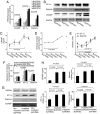Proteins induced by telomere dysfunction and DNA damage represent biomarkers of human aging and disease
- PMID: 18695223
- PMCID: PMC2516278
- DOI: 10.1073/pnas.0801457105
Proteins induced by telomere dysfunction and DNA damage represent biomarkers of human aging and disease
Erratum in
-
Correction for Jiang et al., Proteins induced by telomere dysfunction and DNA damage represent biomarkers of human aging and disease.Proc Natl Acad Sci U S A. 2018 Apr 10;115(15):E3600. doi: 10.1073/pnas.1804185115. Epub 2018 Apr 2. Proc Natl Acad Sci U S A. 2018. PMID: 29610311 Free PMC article. No abstract available.
Abstract
Telomere dysfunction limits the proliferative capacity of human cells by activation of DNA damage responses, inducing senescence or apoptosis. In humans, telomere shortening occurs in the vast majority of tissues during aging, and telomere shortening is accelerated in chronic diseases that increase the rate of cell turnover. Yet, the functional role of telomere dysfunction and DNA damage in human aging and diseases remains under debate. Here, we identified marker proteins (i.e., CRAMP, stathmin, EF-1alpha, and chitinase) that are secreted from telomere-dysfunctional bone-marrow cells of late generation telomerase knockout mice (G4mTerc(-/-)). The expression levels of these proteins increase in blood and in various tissues of aging G4mTerc(-/-) mice but not in aging mice with long telomere reserves. Orthologs of these proteins are up-regulated in late-passage presenescent human fibroblasts and in early passage human cells in response to gamma-irradiation. The study shows that the expression level of these marker proteins increases in the blood plasma of aging humans and shows a further increase in geriatric patients with aging-associated diseases. Moreover, there was a significant increase in the expression of the biomarkers in the blood plasma of patients with chronic diseases that are associated with increased rates of cell turnover and telomere shortening, such as cirrhosis and myelodysplastic syndromes (MDS). Analysis of blinded test samples validated the effectiveness of the biomarkers to discriminate between young and old, and between disease groups (MDS, cirrhosis) and healthy controls. These results support the concept that telomere dysfunction and DNA damage are interconnected pathways that are activated during human aging and disease.
Conflict of interest statement
Conflict of interest statement: K.L.R. has recently submittted a patent application for the discovered biomarkers that are described in this work.
Figures




References
-
- Wright WE, Shay JW. The two-stage mechanism controlling cellular senescence and immortalization. Exp Gerontol. 1992;27:383–389. - PubMed
-
- Lee HW, et al. Essential role of mouse telomerase in highly proliferative organs. Nature. 1998;392:569–574. - PubMed
-
- Jiang H, Ju Z, Rudolph KL. Telomere shortening and ageing. Z Gerontol Geriatr. 2007;40:314–324. - PubMed
-
- Vulliamy T, Marrone A, Dokal I, Mason PJ. Association between aplastic anaemia and mutations in telomerase RNA. Lancet. 2002;359:2168–2170. - PubMed
-
- Mitchell JR, Wood E, Collins K. A telomerase component is defective in the human disease dyskeratosis congenita. Nature. 1999;402:551–555. - PubMed
Publication types
MeSH terms
Substances
LinkOut - more resources
Full Text Sources
Other Literature Sources
Medical
Molecular Biology Databases
Research Materials
Miscellaneous

